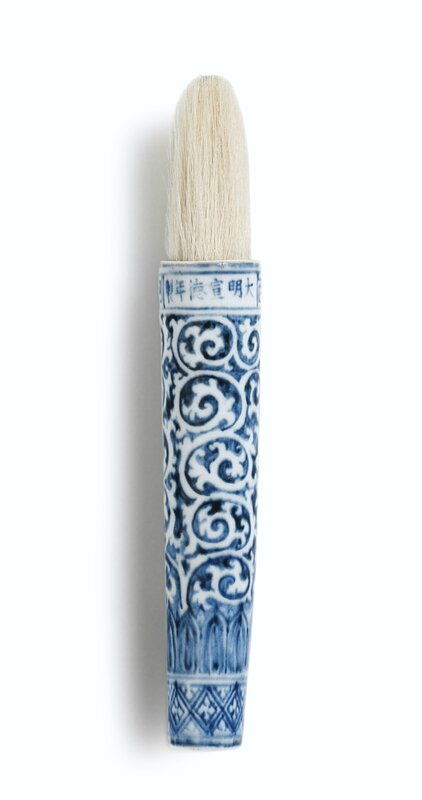An extremely rare blue and white brush handle, Mark and period of Xuande (1426-1435)
Lot 40. An extremely rare blue and white brush handle, Mark and period of Xuande (1426-1435); 14.3 cm., 5 5/8 in. Estimate 3,000,000-4,000,000 HKD. Lot sold 5,060,000 HKD. Photo Sotheby's
of tubular form tapering slightly towards the flat base, densely decorated with foliate scrolls reserved in white on an uneven blue ground, collared with a band of diapers at the tapered end and a cartouche enclosing a six-character reign mark inscribed horizontally flanked by a key-fret border, just below the unglazed socket fitted with dark and light bristles
PROVENANCE: C.T. Loo & Co, New York (1941).
Collection of John A. Foster, Jr., Burmingham, Michigan (1940s-1981).
Sotheby's New York, 6th November 1981, lot 262.
Christie's New York, 1st June 1990, lot 167.
Sotheby's Hong Kong, 25th April 2004, lot 99.
Eskenazi Ltd, London.
EXHIBITED: 'Ming Blue-and-White. An Exhibition of Blue-Decorated Porcelain of the Ming Dynasty', Philadelphia Museum of Art, Philadelphia Museum Bulletin, vol. XLIV, no. 223, Autumn 1949, cat. no. 147.
The Arts of the Ming Dynasty, Detroit Institute of Arts, Detroit, 1952, cat. no. 106.
LITERATURE: Annette L. Juliano, 'Antiques for the Scholar's Table', Architectural Digest, March 1986, p. 149.
Geng Baochang, Ming Qing ciqi jianding [Appraisal of Ming and Qing porcelain], Hong Kong, 1993, pl. 89.
Regina Krahl, Chinese Ceramics from the Meiyintang Collection, London, 1994-2010, vol. 4, no. 1652.
NOTE: No other porcelain brush handle of the Xuande period, or any period prior to the Wanli reign (AD 1573-1620), appears to have survived. The placement of the mark on this piece is somewhat unusual, as it would appear upside down when the brush is in use. However, on later brushes both marks and designs have been applied in various different directions; compare, for example, the brush of Wanli mark and period in this collection, lot 34, where the mark would read correctly from the top while writing, but in that case the dragon design would appear upside down. Although it is not certain that this tubular handle would originally have been designed as a brush handle, any other function would be equally unique. Its present brush of dark and light hairs is still unused.
Sotheby's. The Meiyintang Collection, Part III - An Important Selection of Imperial Chinese Porcelains. Hong Kong | 04 Apr 2012, 10:15 AM

/https%3A%2F%2Fprofilepics.canalblog.com%2Fprofilepics%2F1%2F0%2F100183.jpg)
/https%3A%2F%2Fstorage.canalblog.com%2F03%2F02%2F119589%2F96711876_o.jpg)
/https%3A%2F%2Fstorage.canalblog.com%2F11%2F31%2F119589%2F94773502_o.jpg)
/https%3A%2F%2Fstorage.canalblog.com%2F20%2F83%2F119589%2F94772815_o.jpg)
/https%3A%2F%2Fstorage.canalblog.com%2F26%2F72%2F119589%2F75604929_o.jpg)
/https%3A%2F%2Fstorage.canalblog.com%2F59%2F60%2F119589%2F26458628_o.jpg)




/image%2F1371349%2F20240416%2Fob_2a8420_437713933-1652609748842371-16764302136.jpg)
/image%2F1371349%2F20240414%2Fob_83ee65_2024-nyr-22642-0954-000-a-blue-and-whi.jpg)
/image%2F1371349%2F20240414%2Fob_15808c_2024-nyr-22642-0953-000-a-blue-and-whi.jpg)
/image%2F1371349%2F20240414%2Fob_e54295_2024-nyr-22642-0952-000-a-rare-blue-an.jpg)